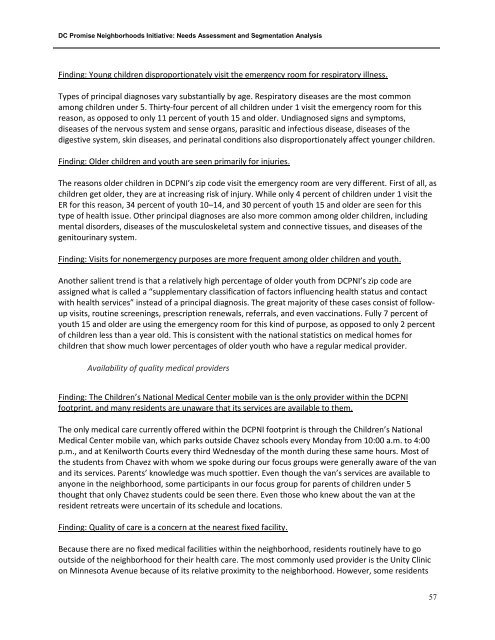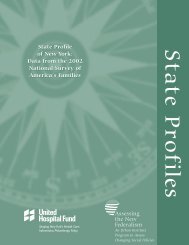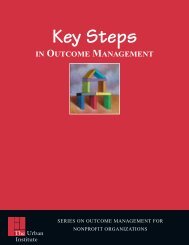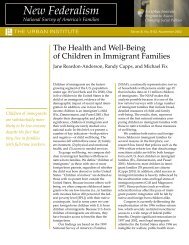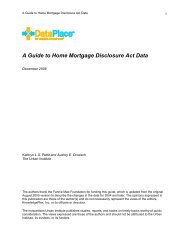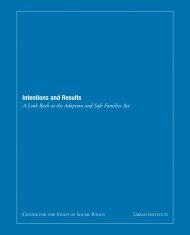DC Promise Neighborhood Initiative: Needs ... - Urban Institute
DC Promise Neighborhood Initiative: Needs ... - Urban Institute
DC Promise Neighborhood Initiative: Needs ... - Urban Institute
You also want an ePaper? Increase the reach of your titles
YUMPU automatically turns print PDFs into web optimized ePapers that Google loves.
<strong>DC</strong> <strong>Promise</strong> <strong>Neighborhood</strong>s <strong>Initiative</strong>: <strong>Needs</strong> Assessment and Segmentation AnalysisFinding: Young children disproportionately visit the emergency room for respiratory illness.Types of principal diagnoses vary substantially by age. Respiratory diseases are the most commonamong children under 5. Thirty-four percent of all children under 1 visit the emergency room for thisreason, as opposed to only 11 percent of youth 15 and older. Undiagnosed signs and symptoms,diseases of the nervous system and sense organs, parasitic and infectious disease, diseases of thedigestive system, skin diseases, and perinatal conditions also disproportionately affect younger children.Finding: Older children and youth are seen primarily for injuries.The reasons older children in <strong>DC</strong>PNI’s zip code visit the emergency room are very different. First of all, aschildren get older, they are at increasing risk of injury. While only 4 percent of children under 1 visit theER for this reason, 34 percent of youth 10–14, and 30 percent of youth 15 and older are seen for thistype of health issue. Other principal diagnoses are also more common among older children, includingmental disorders, diseases of the musculoskeletal system and connective tissues, and diseases of thegenitourinary system.Finding: Visits for nonemergency purposes are more frequent among older children and youth.Another salient trend is that a relatively high percentage of older youth from <strong>DC</strong>PNI’s zip code areassigned what is called a “supplementary classification of factors influencing health status and contactwith health services” instead of a principal diagnosis. The great majority of these cases consist of followupvisits, routine screenings, prescription renewals, referrals, and even vaccinations. Fully 7 percent ofyouth 15 and older are using the emergency room for this kind of purpose, as opposed to only 2 percentof children less than a year old. This is consistent with the national statistics on medical homes forchildren that show much lower percentages of older youth who have a regular medical provider.Availability of quality medical providersFinding: The Children’s National Medical Center mobile van is the only provider within the <strong>DC</strong>PNIfootprint, and many residents are unaware that its services are available to them.The only medical care currently offered within the <strong>DC</strong>PNI footprint is through the Children’s NationalMedical Center mobile van, which parks outside Chavez schools every Monday from 10:00 a.m. to 4:00p.m., and at Kenilworth Courts every third Wednesday of the month during these same hours. Most ofthe students from Chavez with whom we spoke during our focus groups were generally aware of the vanand its services. Parents’ knowledge was much spottier. Even though the van’s services are available toanyone in the neighborhood, some participants in our focus group for parents of children under 5thought that only Chavez students could be seen there. Even those who knew about the van at theresident retreats were uncertain of its schedule and locations.Finding: Quality of care is a concern at the nearest fixed facility.Because there are no fixed medical facilities within the neighborhood, residents routinely have to gooutside of the neighborhood for their health care. The most commonly used provider is the Unity Clinicon Minnesota Avenue because of its relative proximity to the neighborhood. However, some residents57


